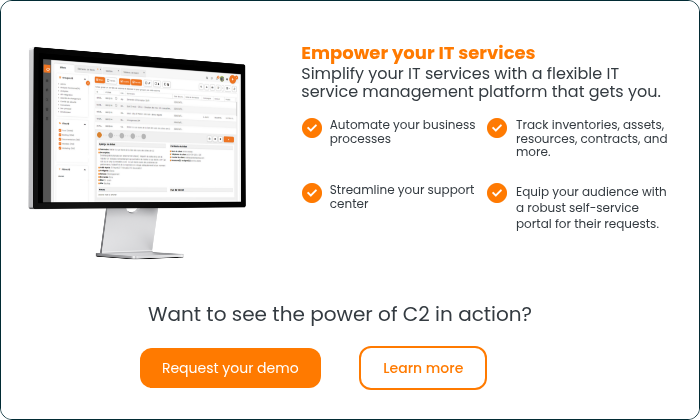Many organizations have seen the benefits of IT service management (ITSM). They’ve seen the value of structuring their information technology into services and might even have adopted some standardized best practices and ITSM software. But not all organizations have chosen to adopt a rigorous framework like ITIL.
The IT Infrastructure Library (ITIL)—as it was originally called over 30 years ago—has been the leading ITSM methodology throughout most of its existence. Its fourth iteration was released several years ago and included substantial updates from ITIL 3.
So what are the actual advantages of ITIL 4? It is worth finding out, no matter whether your organization is an ITIL 3 powerhouse or is still just dipping its toes into ITSM operations.
ITIL is the leading IT service management framework
ITIL gives practicing organizations a framework for better IT service management, which typically leads to the more efficient and effective delivery of IT services to customers. ITIL frameworks create a way to consistently design and deliver services, support those services, and measure overall service delivery, so you know how your organization performs.
One of the other key advantages of using ITIL is that it helps you with day-to-day operations as much as it does with high-level strategic decisions. For example, ITIL provides you with the information you need to understand your services’ total cost of ownership (TCO) and the resources used to deliver them.
What’s new in ITIL 4
A lot has changed in the business and IT worlds since 2007, when ITIL 3 was released. ITIL 4, released in 2019, was updated with the intent to make the framework more relevant to the contemporary world of cloud technology, agile development strategies and digital transformations of wider business processes. It does this by introducing several new concepts:
- The service value chain
- The four dimensions of ITIL 4
- Clarifying processes vs. practices
The service value chain (SVC)
The ITIL Service Value Chain is a model for organizations to create, deliver, and improve the services they deliver. It features six core activities you should take regarding each service you manage.
- Plan
- Engage
- Design and transition
- Obtain/build
- Deliver and support
- Improve
ITIL four dimensions
The four dimensions are the components you need to balance to deliver services using the SVC model effectively. In ITIL 4, they include:
- Organizations and people
- Information and technology
- Partners and suppliers
- Value streams and processes
Processes vs. practices
ITIL 3 emphasized following various service management processes, such as capacity, service level,nd change management. ITIL 4 shifts the focus from processes to more holistic practices.
Processes are part of ITIL 4 practices, but practices pull in many different resources, including those from the four dimensions identified above. In addition, practices touch on the wider organization, not just the IT team that owns a service. This shift in focus from processes to practices recognizes that IT service management philosophies have worked their way into wider business organizations and are now about so much more than technology.
The top 5 advantages of ITIL 4
Now that we understand what is new about the fourth iteration of ITIL, let’s dig into some of its advantages.
It creates business value
A do-it-yourself approach to IT service management can generate value for your organization, but not as much as a battle-tested framework like ITIL 4. ITIL 4 is optimized from over 30 years and thousands of organizations’ experiences. A DIY service management system might suggest good practices to follow, but ITIL 4 is literally best practices.
ITIL 4 integrates with contemporary development frameworks
While ITIL 4 is a comprehensive methodology, this version has also been designed to work better with other popular IT methodologies, notably in the area of development. ITIL 4 incorporates ideas from Agile and DevOps strategies and structures its practices to integrate with teams already following those approaches.
It takes a holistic approach to service management
ITIL methodologies have always stressed taking a holistic, whole-business approach to service management, but version 4 of ITIL takes that thinking to another level. The service value chain in particular tries to unify not only service teams and other operations groups within a business, but with their customers too. ITIL 4 puts a much greater emphasis on the co-creation of value, where customers and businesses work together to generate valuable outcomes from all of their shared, orchestrated efforts.
It offers more flexibility
ITIL 4 was designed from the ground up to help organizations deliver services other than information technology. That practice is called enterprise service management (ESM).
If you can structure a business activity into a service, then you can apply service management principles to it. And ITIL 4 can support it. So, for example, your human resources team might package new hiring requests as a service.
A request from a department head generates a ticket, which goes to an HR officer who completes a standardized process with a defined lifecycle and performance metrics so you can measure and monitor outcomes. The HR office posts the job, manages interviews, selects and evaluates a final candidate, and then hands off the new hire to an intake process. That might trigger its own ESM process.
ITIL 4 adapts to new technology
Version 4 of ITIL was also designed to be more future-proofed than version 3, which was rapidly falling out of step with the latest generation of networked and cloud technologies. That is because too many of ITIL 3’s processes were developed with on-premises infrastructure in mind. Instead, ITIL 4 is designed to support cloud-native organizations and digital transformations.
Organizations looking to the future need to understand the advantages of ITIL 4
ITIL 4 represents an important and meaningful departure from previous frameworks anchored in traditional 20th-century technology and business practices. The introduction of the service value chain, the four dimensions, and a new focus on cloud-based technologies all help position ITIL 4 as an IT service management methodology optimized for the coming decade ahead.





